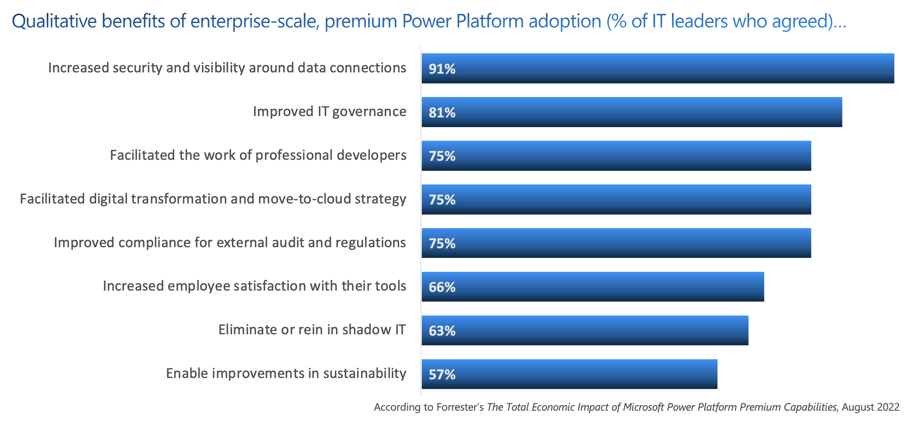Power Platform resources
Learn more about the Microsoft Power Platform

Today’s availability of technology offers unprecedented opportunities for companies - not only in the interaction between customers and suppliers, but it also creates opportunities to accelerate your business with low code. Digital transformation enables your organization to quickly adjust to a constantly changing environment. Andrew Welch, Vice President and director Cloud Application Platform at HSO, will tell more about the transition in the way that organizations buy, use, and enable their own success via technology:
The “Tyranny of the Deliverable”, and other short stories about why you’re struggling to realize big value with Power Platform
A little more than a year ago I put forth a vision for the “Cloud Application Platform” as the next generation approach to Cloud technology. A vision, I argued, best achieved through the use of the Microsoft Cloud specifically. And though I think we’re well far along—over a decade in—on the infrastructure and productivity components of this vision, I speak with very few enterprise CIOs or their teams that have achieved maximum value from their work in the apps and data components generally and Power Platform specifically.
Put simply: Too many organizations are still struggling to go big with Power Platform not because of limitations in technology, but because of their own outmoded ways of doing business.

Now of course, in the early days (way back in 2019) there was a popular line of quasi-acceptable thinking that the technology was unproven and skipping an investment in application platform technology (of which Power Platform is a part) all together was reasonable. That was untrue then—when I was helping a Fortune 100 financial services firm run $2b USD per year through Power Platform solutions—and it is certainly untrue now. Technically speaking, Power Platform has matured to the point where it is essentially a collection of Azure services with a marketing wrapper. And from a business value perspective, well, don’t take it from me. Take it from Forrester, instead, who in August 2022 published The Total Economic Impact of Microsoft Power Platform Premium Capabilities.
First, Forrester interviewed and analyzed the experience of IT decision makers across a collection of organizations. My sense is that this was a good sample because industry representation is quite varied, including professional services (15% of the sample), public sector and related (15%), retail (12%), financial services (12%), and manufacturing (3%). To be clear, we’re talking about enterprise-scale organizations here.
The findings are tremendous, both quantitatively and qualitatively in terms of the percentage of IT decision makers in the study who agreed their organization had derived a series of benefits such as “improved IT governance” or “improved compliance for external audit and regulations”.

I’ve worked with a lot of IT and business decision makers throughout my career, and I struggle to think of many circumstances in which such significant positive results could be delivered to an organization via technology adoption… and where such claims were supported by independent research.
That is to say: I know of no other move that IT decision makers in organizations across the economy and around the world can make that is likely to achieve results of this magnitude by—in effect—doing more with less. It is an opportunity that absolutely must be seized, and a can’t-afford-not-to-situation when your peers inevitably do. As such, it’s a transformation on which IT decision makers must lead from the front.
But these benefits are often dampened by three big, non-technical reasons that I see so many organizations failing or underperforming in their scaled, enterprise Power Platform adoption:
Which is why straight away in a discussion with one of those leaders I want to understand where they stand on the million (or $14.25 million) dollar question:
I cannot possibly overstate how important it is for IT leaders, their teams, their partners and consultants, and everyone else in your ecosystem to have a really clear, executive-driven answer to this question. The value that Forrester found in successful organizations didn’t just happen. It is not spontaneous, and it is not easy. It’s the product of commitment to and sustained effort towards achieving that value.
So… Fantastic if you are! I’ve spent a great deal of time on these challenges, seeing some organizations succeed, and others fail. So I’ve also put great effort into re-imagining specifics of the journey that organizations ought to be taking as they get started.
For now I will leave you with this: I get it. This is a challenging road. Forrester’s study was built around a three-year time horizon, so consider the benefits that IT can drive for the broader organization if you really do commit. That’s why I always want to understand where a CIO stands early in our work together. More importantly, you should understand it in yourself, for your own organization. The outcomes available to you are tremendous.
Power Platform resources
Learn more about the Microsoft Power Platform
Wij, en derde partijen, gebruiken cookies op onze website. We gebruiken cookies om statistieken bij te houden, uw voorkeuren op te slaan, maar ook voor marketingdoeleinden (bijvoorbeeld het op maat aanbieden van advertenties). Door op 'Instellingen' te klikken kunt u meer lezen over onze cookies en uw voorkeuren aanpassen. Door op 'Alles accepteren' te klikken, ga je akkoord met het gebruik van alle cookies zoals beschreven in onze privacy- en cookie policy.
Purpose
This cookie is used to store your preferences regarding cookies. The history is stored in your local storage.
Cookies
Location of Processing
European Union
Technologies Used
Cookies
Expiration date
1 year
Why required?
Required web technologies and cookies make our website technically accessible to and usable for you. This applies to essential base functionalities such as navigation on the website, correct display in your internet browser or requesting your consent. Without these web technologies and cookies our website does not work.
Purpose
These cookies are stored to keep you logged into the website.
Cookies
Location of Processing
European Union
Technologies Used
Cookies
Expiration date
1 year
Why required?
Required web technologies and cookies make our website technically accessible to and usable for you. This applies to essential base functionalities such as navigation on the website, correct display in your internet browser or requesting your consent. Without these web technologies and cookies our website does not work.
Purpose
This cookie is used to submit forms to us in a safe way.
Cookies
Location of Processing
European Union
Technologies Used
Cookies
Expiration date
1 year
Why required?
Required web technologies and cookies make our website technically accessible to and usable for you. This applies to essential base functionalities such as navigation on the website, correct display in your internet browser or requesting your consent. Without these web technologies and cookies our website does not work.
Purpose
This service provided by Google is used to load specific tags (or trackers) based on your preferences and location.
Why required?
This web technology enables us to insert tags based on your preferences. It is required but adheres to your settings and will not load any tags if you do not consent to them.
Purpose
This cookie is used to store your preferences regarding language.
Cookies
Why required?
We use your browser language to determine which language to show on our website. When you change the default language, this cookie makes sure your language preference is persistent.
Purpose
This service is used to track anonymized analytics on the HSO.com application. We find it very important that your privacy is protected. Therefore, we collect and store this data anonymously on our own servers. This cookie helps us collect data from HSO.com so that we can improve the website. Examples of this are: it allows us to track engagement by page, measuring various events like scroll-depth, time on page and clicks.
Cookie
Purpose
With your consent, this website will load Google Analytics to track behavior across the site.
Cookies
Purpose
With your consent, this website will load the Google Advertising tag which enables HSO to report user activity from HSO.com to Google. This enables HSO to track conversions and create remarketing lists based on user activity on HSO.com.
Possible cookies
Please refer to the below page for an updated view of all possible cookies that the Google Ads tag may set.
Cookie information for Google's ad products (safety.google)
Technologies Used
Cookies
Purpose
With your consent, we use IPGeoLocation to retrieve a country code based on your IP address. We use this service to be able to trigger the right web technologies for the right people.
Purpose
With your consent, we use Leadfeeder to identify companies by their IP-addresses. Leadfeeder automatically filters out all users visiting from residential IP addresses and ISPs. All visit data is aggregated on the company level.
Cookies
Purpose
With your consent, this website will load the LinkedIn Insights tag which enables us to see analytical data on website performance, allows us to build audiences, and use retargeting as an advertising technique. Learn more about LinkedIn cookies here.
Cookies
Purpose
With your consent, this website will load the Microsoft Advertising Universal Event Tracking tag which enables HSO to report user activity from HSO.com to Microsoft Advertising. HSO can then create conversion goals to specify which subset of user actions on the website qualify to be counted as conversions. Similarly, HSO can create remarketing lists based on user activity on HSO.com and Microsoft Advertising matches the list definitions with UET logged user activity to put users into those lists.
Cookies
Technologies Used
Cookies
Purpose
With your consent, this website will load the Microsoft Dynamics 365 Marketing tag which enables HSO to score leads based on your level of interaction with the website. The cookie contains no personal information, but does uniquely identify a specific browser on a specific machine. Learn more about Microsoft Dynamics 365 Marketing cookies here.
Cookies
Technologies Used
Cookies
Purpose
With your consent, we use Spotler to measures more extensive recurring website visits based on IP address and draw up a profile of a visitor.
Cookies
Technologies Used
Cookies
Purpose
With your consent, this website will show videos embedded from Vimeo.
Technologies Used
Cookies
Purpose
With your consent, this website will show videos embedded from Youtube.
Cookies
Technologies Used
Cookies
Purpose
With your consent, this website will load the Meta-pixel tag which enables us to see analytical data on website performance, allows us to build audiences, and use retargeting as an advertising technique through platforms owned by Meta, like Facebook and Instagram. Learn more about Facebook cookies here. You can adjust how ads work for you on Facebook here.
Cookies
Purpose
With your consent, we use LeadInfo to identify companies by their IP-addresses. LeadInfo automatically filters out all users visiting from residential IP addresses and ISPs. These cookies are not shared with third parties under any circumstances.
Cookies
Purpose
With your consent, we use TechTarget to identify companies by their IP address(es).
Cookies
Purpose
With your consent, we use this service provided by uMarketingSuite to run A/B tests across the HSO.com application. A/B testing (also called split testing) is comparing two versions of a web page to learn how we can improve your experience.
Purpose
With your consent, we use this service provided by uMarketingSuite to personalize pages and content across the HSO.com application. Personalization helps us to tailor the website to your specific needs, aiming to improve your experience on HSO.com.
Purpose
With your consent, we use ZoomInfo to identify companies by their IP addresses. The data collected helps us understand which companies are visiting our website, enabling us to target sales and marketing efforts more effectively.
Cookies